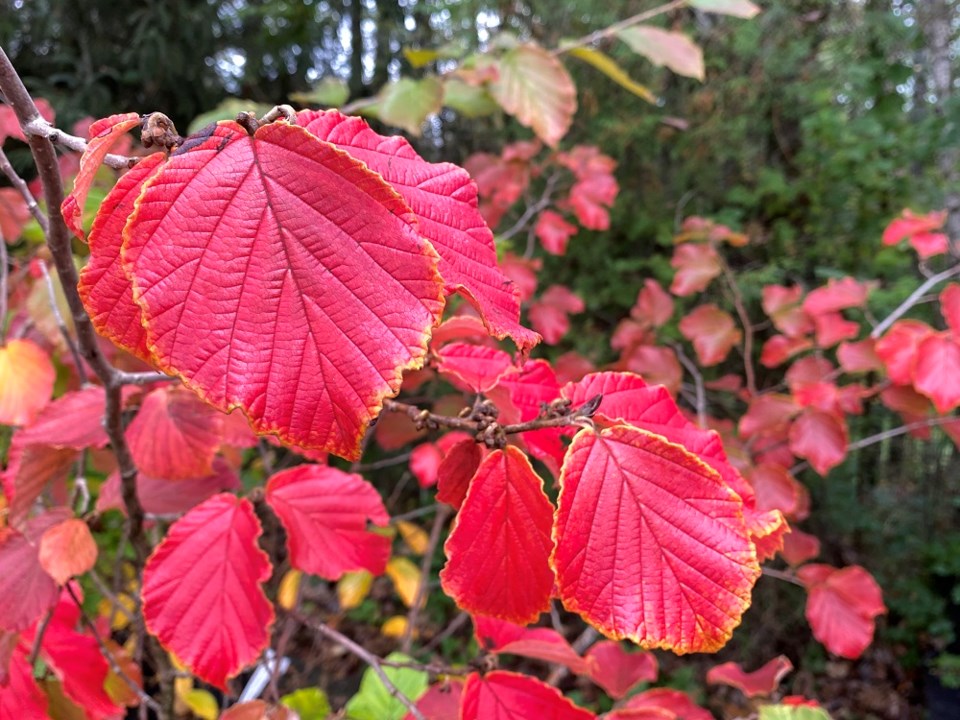As the green leaves of summer transition to their autumn colours, it might be worthwhile to look at our own landscapes to see how we can bump up our fall show.
More and more folks are decorating their yards for Halloween and Christmas, so why not work with nature to create a spectacular colour display — one which can last for weeks, get better each year, help our environment and our pollinators and birds, and at the same time, create something that you can look forward to enjoying year after year.
Not all the colour needs to come from larger trees as many lesser-known shrubs have equally stunning fall colour.
Many of us are familiar with Euonymus alatus, commonly known as the burning bush. It comes in a compact form, as well as the two- to three-meter-tall varieties that make nice hedges.
There are, however, so many more.
Itea virginica (sweetspire), one of my favourites, produces masses of fragrant, drooping white flowers in August and September and then fires up with red toned leaves in September and October.
Fothergillas (bottle brush plant) are another fragrant spring flowering shrub that has stunning orange and red autumn colour, and, as we wait for their winter flowers to appear in our gardens, Chinese witch hazels will treat us to an October colour show.
Many compact viburnums, like the common snowball bush, have rich burgundy-orange foliage, as do weigelas, like Proven Winners’ "My Monet" and "My Monet Purple Effect."
The compact sumac, Rhus "Tiger Eyes," has golden foliage which turns into a delightful range of reds and oranges.
Few other tree families can match the fantastic colour range of Japanese maples.
Available in all sizes and tree forms, they are some of the most versatile garden plants for screening, for providing shade and just for their sheer beauty. The many green leafed varieties have the most gorgeous fall colour range of yellows, oranges and reds. Even the common green Acer palmatum has great colour.
The leaves of Acer griseum (the peeling bark maple) turn a brilliant red, and its bronze peeling bark looks stunning all winter. Acer "Osakazuki," which seems to turn various colours all summer, has the reddest of red leaves in fall. Now is the best time of the year to see them in nurseries to get a real sense of the many different colour variations.
And the list goes on.
Dogwoods provide a nice treat in fall, from the pure reds of Cornus "Eddie’s White Wonder" to the stunning array of colours in the large Cornus kousa family.
Oxydendrum arboreum (sourwood tree), one of my favourites, not only flowers in August and September with massive white panicles, but its foliage begins to turn multi coloured almost immediately after flowering.
Parrotias, like "Persian Spire" or "Ruby Vase," transition into the most beautiful shades of orange, red, yellow and burgundy. Many taller maples display the spectacular reds that are missing in our West Coast native trees.
Acer saccharum (sugar maple) is one of the most brilliant and is featured on the centre of our Canadian flag. Most of the Acer rubrum family bring a brilliant show of reds to our parks and gardens at this time of the year, and their colour lasts for weeks.
Now is a great time to consider planting some trees and shrubs, particularly those that can add brilliant fall colour to your garden for years to come. They will also help our environment, cool our homes and provide habitat for birds and pollinators.
Take a good look around your garden, and imagine the many values some new plants could add.



